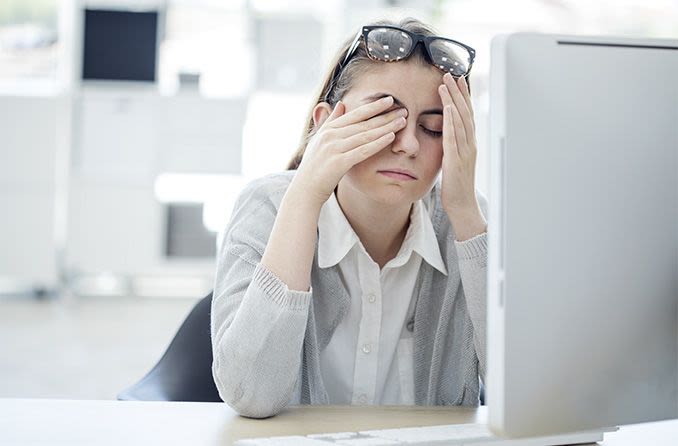Tired eyes: How to deal with eye fatigue

What are tired eyes?
Tired eyes are a common result of extended eye strain, like staring at a screen all day or driving long distances.
Tired eyes will not cause permanent eye damage, but it's still important to recognize the symptoms of tired eyes so you can make changes to retain and improve eye comfort.
Unsurprisingly, your eyes probably feel heavy and fatigued after staring at a computer screen for long periods of time. According to The Vision Council, 32% of the 80% of Americans who use a digital device have experienced fatigue and tired eyes, also known as eye strain.
And drivers know that staring at that yellow line on the highway or even at the horizon can create a similar effect.
Other causes of eye fatigue include being exposed to poor lighting or having a slow eye-blinking rate.
Here's what you need to know about tired eyes and eye fatigue:
What are the symptoms of tired eyes?
The most common symptoms of eye fatigue include:
Watery eyes
Red, itchy and irritated eyes
Headaches
Eye twitching
Blurred or double vision
Neck and shoulder pain
But don’t always assume these symptoms are simply the result of tired eyes. Prolonged headaches or continuously red, dry and itchy eyes could be a sign of allergies, infections or more serious conditions like glaucoma.
If any of these symptoms persist or become unmanageable, you should see your eye doctor.
Why are my eyes tired all the time?
Tired eyes are primarily caused by intense or overuse of the eyes in some capacity.
Staring at computer screens, televisions and mobile devices is a major cause of ongoing eye fatigue. Americans spend as many as 12 hours a day staring at screens! No wonder our eyes are so tired.
Computer glasses, or blue-light glasses, may help reduce eye strain caused by constantly at screens at work and digital devices at home.
Additionally, those who drive long commutes are more likely to experience eye fatigue because they are forced to focus in one direction for extensive periods of time.
Tired eyes can also be the result of lack of sleep, reading without taking breaks, exposure to dry air, straining to see in dim lighting and having uncorrected vision.
Once you've isolated the possible cause or causes of your tired eyes, make some changes to give your eyes a bit more rest.
For example, evaluating your sleep habits is a great place to start. Getting enough sleep at night should reduce your eye strain.
And if you tend to stare at the computer screen for too long, take a break (or more breaks). Check your work environment, too, as your eyes may benefit from more or less light.
SEE RELATED: What are blue-light glasses and do you need them?
How to relieve tired eyes
While a good night’s sleep is key to recharging your eyes, sometimes rest is not enough to relieve eye discomfort or eliminate the symptoms of eye fatigue.
To relieve eye irritation, flush out your eyes with a saline rinse or water. Or, apply a warm washcloth to both eyes. Using eye drops can also help relieve any dryness or itchiness and bring some moisture back to your eyes.
To help prevent tired eyes at work, take breaks from staring at your screen. Look off into the distance periodically to let your eyes rest and refocus, or go for short 20-minute walks throughout the day for a change of scenery.
Also, consider changing the position of your computer screen so that it sits 20–26 inches away from your face, and clean your computer screen regularly and reduce glare.
On long drives, stopping briefly can let your eyes rest and readjust, and make sure you don’t have any issues with night vision before driving long distances at night.
READ MORE: 5 ways to relieve tired eyes
Page published on Sunday, February 9, 2020




